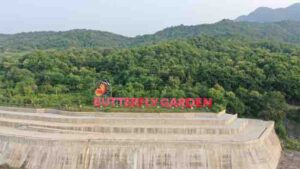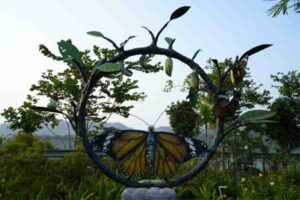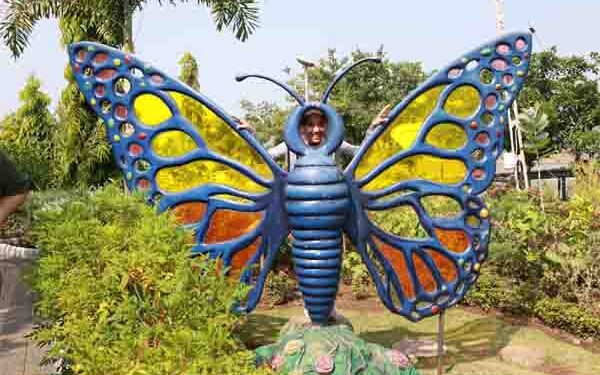- The Butterfly Garden features 70 different species of butterflies
- Spread across 10 acres, the garden contains 150 species of nectar and host plants
- These plants provide essential nourishment for the butterflies and serve as a habitat for egg-laying and their conservation
R ARIVANANTHAM
GANDHINAGAR, SEPT 2
The Butterfly Garden in Gujarat located at the Statue of Unity in Ekta Nagar, Kevadia is becoming a major tourist hub not only for backpackers from India but also from neighbouring countries alike. With monsoon playing its magic spell, the flapping beauties with vibrant colours woo nature lovers to Statue of Unity. One can learn a lot from Mother Nature than the corridors of education. This is the best place for kids to get unlimited edutainment.

Statue of Unity in the lap of Mother Nature
The Statue of Unity in Ekta Nagar, along with its surrounding areas, has emerged as a major attraction for tourists worldwide. Continuous efforts are being undertaken to develop new tourist attractions at the Statue of Unity, enhancing the visitors’ experience. One such serene and picturesque destination along the tranquil banks of the Narmada River is the Butterfly Garden. This garden allows visitors to observe various species of butterflies in their natural habitat. Spanning 10 acres, the Butterfly Garden is home to 70 different species of butterflies and 150 species of nectar and host plants. These plants provide essential nourishment for the butterflies and serve as a habitat for egg-laying and their conservation.
Brainchild of Prime Minister Narendra Modi
It is noteworthy that under the visionary leadership of Prime Minister Narendra Modi, the world’s tallest statue, the 182-metre Statue of Unity dedicated to Sardar Vallabhbhai Patel, was established in Ekta Nagar, Gujarat. The Prime Minister envisioned the Statue of Unity and its surroundings as a premier tourist destination, a vision that has been successfully realised. Under the guidance of Chief Minister Bhupendra Patel, the Statue of Unity Area Development and Tourism Governance Authority (SoUADTGA) is committed to enhancing visitor amenities and ensuring a pleasant and enriching experience for all.
Nectar and Host Plants
Each butterfly species has a specific host plant. Of the total 150 plants, to cater to the diverse needs of the 70 butterfly species inhabiting the Butterfly Garden, 70 distinct host plants have been cultivated. For instance, the Plain Tiger butterfly is attracted to the Akra plant, the Common Crow butterfly prefers the Kaner plant, while the Lime Butterfly is drawn to the lemon tree.

Diverse Butterfly Species
The Butterfly Garden hosts 70 different species of butterflies, including the Common Crow, Plain Tiger, Blue Tiger, Striped Tiger, Glassy Tiger, Mottled Emigrant, Lemon Pansy, Chocolate Pansy, Peacock Pansy, Common Rose, Crimson Rose, Black Rajah, Indian Jezebel, Eggfly, Painted Lady, Plain Cupid, Sunbeam, Lime Swallowtail, Red Helen, Blue Mormon, Evening Brown, and Red Parrot, among others.
Butterfly Life Cycle
Visitors to the Butterfly Garden have the opportunity to observe the complete life cycle of butterflies. The life cycle begins with an egg, from which a small caterpillar emerges. The caterpillar then feeds voraciously, growing rapidly in preparation for its transformation. It enters the ‘Pupa’ (Chrysalis) stage, undergoing a significant metamorphosis within a protective casing. After approximately 25 days, a fully developed butterfly emerges. The lifespan of butterflies typically ranges from 2 to 4 weeks, during which they play a crucial role in the pollination process. Notably, the Butterfly Garden includes two unique plant species, ‘Ghughra’ and ‘Hathi Sundhi,’ which specifically attract male butterflies.
Designated Photo Points
The Butterfly Garden features three designated photo points: 1) Selfie Point, 2) Butterfly Life Cycle Display, and 3) The Entrance to the Butterfly Garden. These locations provide visitors with the opportunity to capture their memorable experiences in photographs.












